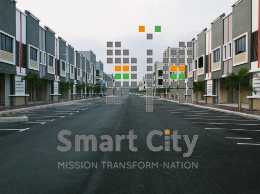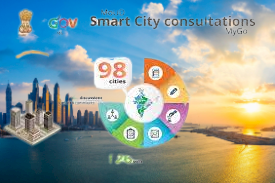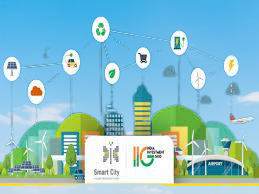Smart Cities Mission: Building the Future of Urban Living
In today’s rapidly evolving world, cities face numerous challenges ranging from population growth to resource management. To tackle these issues effectively, the concept of smart cities has emerged as a solution that leverages technology and innovation to create sustainable and efficient urban environments. In this article, we will explore the Smart Cities Mission, its components, benefits, challenges, and successful examples, highlighting the transformative potential of this initiative.
Introduction

Smart cities are urban areas that integrate cutting-edge technologies and data-driven approaches to enhance the quality of life for residents while ensuring sustainable development. The Smart Cities Mission, launched by the Government of India in 2015, aims to transform 100 cities across the country into smart cities. These cities are envisioned to be efficient, citizen-friendly, and responsive to the needs of their residents.
Defining Smart Cities
Smart cities are urban areas that integrate cutting-edge technologies, digital infrastructure, and data analytics to enhance various aspects of urban living. These cities employ intelligent systems and services to optimize resource management, enhance connectivity, and promote sustainable development. By adopting smart technologies, smart cities aim to improve governance, mobility, utilities, healthcare, education, and overall urban infrastructure.
Components of a Smart City

A smart city comprises various interconnected components that work together to create an intelligent urban ecosystem. Read also- Griha Jyoti scheme
Infrastructure and Connectivity
Digital connectivity:
Smart cities rely on robust digital infrastructure, ensuring seamless connectivity and access to high-speed internet for residents, businesses, and government services. This connectivity forms the backbone of the city’s digital ecosystem, enabling the implementation of innovative solutions.
Efficient transportation systems:
Smart cities prioritize efficient and sustainable transportation systems. This includes intelligent traffic management, real-time information dissemination, smart parking solutions, and the integration of electric and autonomous vehicles. Such measures aim to reduce congestion, enhance mobility, and minimize environmental impact.
Smart energy management:
Energy efficiency is a crucial aspect of smart cities. Implementing smart grids, renewable energy sources, and energy-efficient buildings not only reduces carbon emissions but also ensures a reliable and sustainable energy supply for residents and businesses.
Governance and Services

E-governance initiatives:
Smart cities leverage digital technologies to streamline governance processes and enhance service delivery. This includes online citizen portals, digital payment systems, and e-participation platforms, enabling efficient and transparent governance.
Citizen engagement platforms:
To foster active participation and collaboration between citizens and the government, smart cities employ platforms for citizen feedback, grievance redressal, and community-driven initiatives. This empowers residents to contribute to the decision-making processes and collectively shape their city’s development.
Smart healthcare and education:
Smart cities prioritize the integration of technology in healthcare and education services. This includes telemedicine, smart hospitals, e-learning platforms, and digital classrooms, ensuring accessible and quality healthcare and education for all residents.
Sustainability and Environment
Green initiatives:
Smart cities adopt sustainable practices and promote green initiatives to minimize environmental impact. This involves initiatives like green buildings, urban farming, efficient waste management, and water conservation measures.
Waste management systems:
Smart cities implement intelligent waste management systems that optimize collection routes, monitor bin levels, and encourage waste segregation. These systems reduce operational costs, improve cleanliness, and promote recycling and waste reduction.
Renewable energy integration:
To combat climate change, smart cities focus on integrating renewable energy sources such as solar and wind power. This shift towards clean energy not only reduces greenhouse gas emissions but also ensures a reliable and sustainable energy supply for the city.
Benefits of Smart Cities

The development of smart cities brings forth a range of benefits that positively impact the lives of residents and contribute to economic growth and environmental sustainability.
Improved Quality of Life
Enhanced safety and security:
Smart cities leverage technologies like video surveillance, sensor networks, and data analytics to improve public safety and security. This includes real-time monitoring, early warning systems, and efficient emergency response, creating safer urban environments.
Efficient public services:
Through the integration of technology and data-driven approaches, smart cities optimize public services such as transportation, healthcare, waste management, and utilities. This leads to improved service delivery, reduced waiting times, and increased convenience for residents.
Smart urban planning:
By harnessing data and predictive analytics, smart cities enable efficient urban planning and resource allocation. This results in optimized land use, improved traffic management, and better urban infrastructure, enhancing the overall livability of the city.
Economic Growth
Job creation:
The development of smart cities stimulates economic growth and creates employment opportunities. As technology and innovation flourish, new industries emerge, attracting investments and generating jobs in sectors such as IT, telecommunications, clean energy, and urban services.
Innovation and entrepreneurship:
Smart cities provide an ideal environment for innovation and entrepreneurship. The integration of technology and the availability of supportive ecosystems foster collaboration, creativity, and the development of startups, driving economic progress.
Increased investments:
Smart cities offer attractive investment opportunities due to their potential for growth and the promise of sustainable development. Investors are drawn to cities that prioritize infrastructure development, digital connectivity, and the well-being of their residents, leading to increased financial inflows.
Environmental Sustainability
Reduction in carbon emissions: Smart cities implement measures to reduce carbon emissions, such as promoting sustainable transportation, optimizing energy consumption, and embracing renewable energy sources. These actions contribute to mitigating climate change and creating a greener future.
Conservation of resources:
By employing smart technologies for resource management, smart cities minimize water wastage, optimize energy usage, and reduce the overall consumption of resources. This fosters a more sustainable and responsible approach towards resource utilization.
Sustainable infrastructure:
Smart cities prioritize the development of sustainable infrastructure that incorporates eco-friendly materials, energy-efficient systems, and green spaces. This integration of sustainability principles into urban development ensures a harmonious coexistence between nature and urban life.
Challenges and Considerations

While the vision for smart cities is promising, several challenges and considerations must be addressed to ensure their successful implementation.
Data Privacy and Security
Protection of personal information:
As smart cities collect and analyze vast amounts of data, ensuring the privacy and security of citizens’ personal information is of utmost importance. Robust data protection laws and secure infrastructure are essential to maintaining public trust.
Cybersecurity risks:
Smart cities are susceptible to cyber threats, including data breaches and hacking attempts. Implementing stringent cybersecurity measures and fostering a culture of data security are crucial to safeguarding the city’s digital ecosystem.
Cost and Affordability
Funding and financial implications:
Developing and maintaining smart cities requires substantial investments. Governments need to explore innovative financing models, public-private partnerships, and grant funding to overcome financial barriers and ensure the affordability of smart infrastructure and services.
Ensuring accessibility for all:
Smart cities must prioritize inclusivity and accessibility to ensure that all residents, regardless of socioeconomic background, can benefit from the advancements. Bridging the digital divide and providing equal access to technology and services are critical considerations.
Stakeholder Collaboration
Public-private partnerships:
Successful implementation of smart cities necessitates collaboration between the government, the private sector, and the community. Building strong partnerships and engaging stakeholders in decision-making processes fosters a sense of ownership and collective responsibility.
Community involvement:
The active participation of residents in shaping the development of their city is crucial. Encouraging citizen engagement, conducting awareness campaigns, and involving communities in planning and decision-making ensure that smart cities truly reflect the needs and aspirations of the people.
Success Stories and Examples

Several cities worldwide have made significant progress in implementing smart city initiatives. Here are a few notable examples:
Singapore’s Smart Nation Initiative
Singapore has emerged as a global leader in smart city development. Its Smart Nation Initiative focuses on harnessing technology to improve urban living. Initiatives include smart mobility solutions, digital government services, and the use of data analytics for urban planning. Singapore’s commitment to innovation and collaboration has positioned it as a prime example of a successful smart city. Read more about smart cities
Barcelona’s Smart City Strategy
Barcelona, Spain, has embraced a comprehensive smart city strategy that encompasses various sectors, including energy, mobility, and governance. The city has implemented smart traffic management systems, sustainable buildings, and citizen participation platforms. Barcelona’s commitment to sustainability and citizen-centric solutions has garnered international recognition.
Songdo, South Korea
Songdo, a city built from scratch near Seoul, South Korea, showcases a futuristic smart city model. It integrates cutting-edge technologies, such as smart grids, intelligent buildings, and an extensive network of sensors. Songdo’s emphasis on sustainability and efficient urban planning has positioned it as a blueprint for future smart city development.
Conclusion

The Smart Cities Mission and the concept of smart cities hold immense potential to transform urban living. By integrating technology, sustainability, and citizen participation, smart cities can enhance the quality of life, drive economic growth, and promote environmental sustainability. However, challenges such as data privacy, cost considerations, and stakeholder collaboration must be addressed to ensure the successful implementation of these initiatives. As cities worldwide embrace the smart city vision, they pave the way for a smarter, more connected, and sustainable future.
FAQs
What is the Smart Cities Mission?
The Smart Cities Mission is an initiative launched by the Government of India to transform 100 cities across the country into smart cities. These cities leverage technology and innovation to enhance livability, sustainability, and efficiency.
What are the benefits of smart cities?
Smart cities offer improved quality of life, economic growth through job creation and innovation, and environmental sustainability through reduced carbon emissions and resource conservation.
What are the challenges in implementing smart cities?
Challenges include data privacy and security, cost and affordability, and stakeholder collaboration. Addressing these challenges is crucial for the successful development of smart cities.
Which cities have successfully implemented smart city initiatives?
Cities like Singapore, Barcelona, and Songdo in South Korea have made significant progress in implementing smart city initiatives and serve as successful examples of the transformative potential of smart cities.
How can citizens get involved in shaping smart cities?
Citizen involvement is crucial in shaping smart cities. Engaging in community initiatives, participating in citizen feedback platforms, and contributing to decision-making processes are ways for residents to actively participate in the development of their cities.